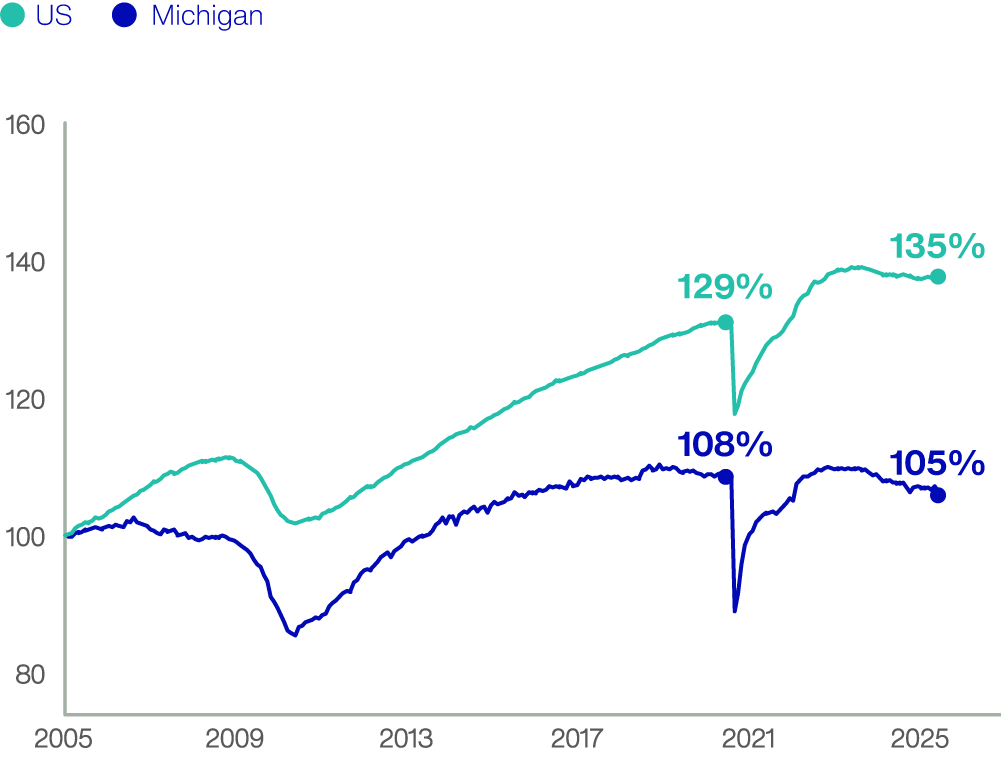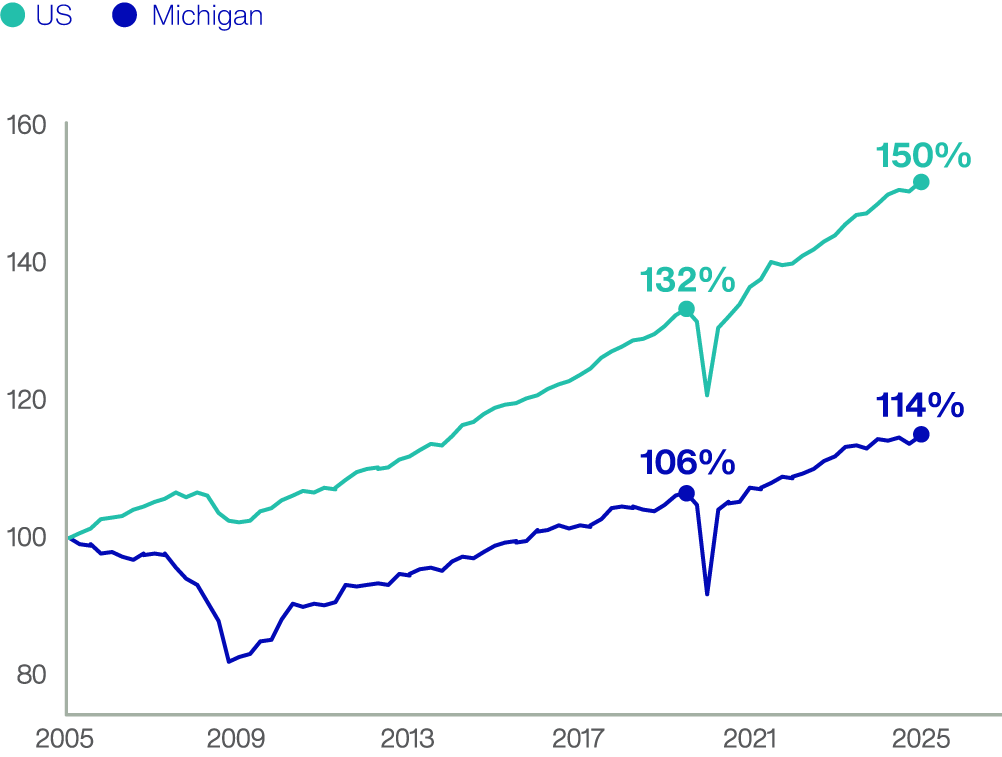Michigan in a New Era:
Activate Michigan’s Economic Potential
A strong economy drives prosperity for families, businesses and communities. Michigan’s long struggle with income growth shows that we have work to do to strengthen competitiveness and expand opportunity. Other states are moving quickly to attract talent, capital and new industries; Michigan must do the same. A modern, well-coordinated economic development system can help close our competitive gaps by aligning public tools and private investment to unlock sites, streamline permitting and support growth in every region. By reducing redevelopment costs, improving the ease of doing business and building on regional strengths, we can create the conditions for more high-wage jobs, thriving businesses and broadly shared prosperity.
Consider where Michigan stands today:
Slow economic growth
Our economy has grown at only about one-third the national pace over the last 20 years.
Brain drain
The state’s top universities are powerhouses for training in growing fields, but only 46% of STEM graduates remain in the state.
Talent attraction
States that thrive are talent magnets, but Michigan ranks second to last in the percentage of residents born elsewhere.
Activating Michigan’s economic potential means both unlocking the full value of what we already have and attracting new investment that strengthens and diversifies our economy. Strong economic development systems country demonstrate a few key elements: a clear and shared vision, empowered regions, and the structure and long-term funding to ensure consistency and drive progress.
Professional services employment is growing in the US, but not in Michigan
Employment in Professional and Business Services

Source: US Bureau of Labor Statistics
US real GDP grew 3x faster than Michigan’s over the last 20 years
Real GDP

Actions to Take
1. Build the economic development system of the future.
Michigan’s size, geography and concentration in industries facing decades of steep global competition and disruption create a unique challenge for the state’s economy. The economic development system of the future must meet that challenge through a collective effort — one that diversifies and strengthens Michigan’s competitive advantages, grows industries and incomes, and builds on what’s uniquely Michigan.
The Michigan Economic Development Corporation (MEDC) — the state’s public-private economic development organization — was groundbreaking when it was founded in 1999. Its design inspired other states to form similar partnerships. Those states found success in pairing the model with steady political alignment, long-term focus and strong fundamentals — conditions that Michigan has found hard to sustain. No single organization can transform a state’s economy alone.
Concerns about transparency, oversight and uneven results have left some questioning the value of economic development. These challenges only underscore the need for a stronger, more accountable approach — not for abandoning the field. Michigan is in competition every day for jobs, talent and investment. Without a well-run, connected and transparent system, we risk being left further behind.
To position Michigan for success, the state must reimagine and strengthen our entire economic development framework — building a clear and enduring vision for growth, ensuring consistent and transparent governance, and empowering regional partners to lead with their strengths. The goal is not just to restore confidence, but to create a system that consistently delivers results: helping businesses of all sizes grow, removing barriers that slow investment and ensuring that every region of Michigan can compete and win.
-
Vision: Define a unifying vision that commands broad support.
Michigan needs a statewide plan that everyone backs — from Detroit to the Upper Peninsula and from state agencies to local partners. It should build on and empower regional strengths and stay focused on outcomes: more high-quality jobs, durable career paths, breaking barriers that slow projects or deter growth, and more investment. And it should endure across administrations. The vision should center on core functions:
- Diversifying the state’s economy
- Attracting and retaining companies, talent and investment
- Supporting and scaling small businesses
- Navigating and removing barriers to growth for new and legacy industries
These core functions should enable major initiatives to support and grow industry ecosystems, including catalyzing the innovation economy, maintaining R&D dominance, and expanding startup and scale-up supports.
- Regions: Empower and leverage regional strengths. Strong regional economies power statewide growth. Regional economic development organizations are essential: they are well-positioned to understand local assets and workforce needs; to build ties to local governments, colleges and universities, utilities and employers; and to help small businesses grow. Michigan should strengthen regional organizations to deepen local competitive advantages and improve industry ecosystems by enhancing their capabilities, providing needed resources and removing duplication with state agencies — establishing clear roles, shared metrics and accountability, and predictable support.
- Structure and funding: Ensure stability, independence and accountability. Michigan’s economic development funding and tool kit is unpredictable — tied to annual appropriations and economic swings — making long-term planning and competitiveness difficult to maintain. To restore consistency, the state should establish dedicated, multiyear funding with clear performance guardrails, public transparency and effective oversight. It should also update the public-private model to align with a shared statewide vision — strengthening governance to ensure organizational focus, wise use of funds and efficient operations.
2. Attract and retain talent for Michigan.
Michigan must directly address both its current and future talent needs. The education section highlights important steps: improving high school graduation standards, expanding CTE, adopting competency-based learning and connecting students seamlessly to apprenticeships, college and career. All will strengthen Michigan’s talent competitiveness.
But this won’t be enough. Michigan’s demographic realities demand that we do more to attract and retain young people and college graduates who can help drive our economy forward. Too many communities lack the amenities that make places vibrant and appealing to young people. That’s why actions to make Michigan the easiest state to build and grow — and to empower regions — are so critical. Michigan must be able to activate local placemaking, transit and housing to make our state an undeniably great place to live and work.
Finally, Michigan must do more to attract the talent that can help our economy grow and effectively recruit them to our state. This requires a focused effort to enhance the qualities of our communities that young people value most, along with a coordinated campaign and tools to reach the talent Michigan needs.
- Support regional economic development partners and organizations to enhance regional advantages — from recreation to transit to vibrant neighborhoods — as great places that people want to build full lives.
- Expand retention and attraction tools to tip the balance on decision-making and link students and graduates with in-state employers, mentors and professional networks.
- Launch targeted campaigns that market Michigan as a place where the best and brightest can live, work and thrive — combining job opportunities with quality-of-life storytelling.
- Target alumni and high-demand professionals who left Michigan with tailored outreach to bring them back to invest, work and live.